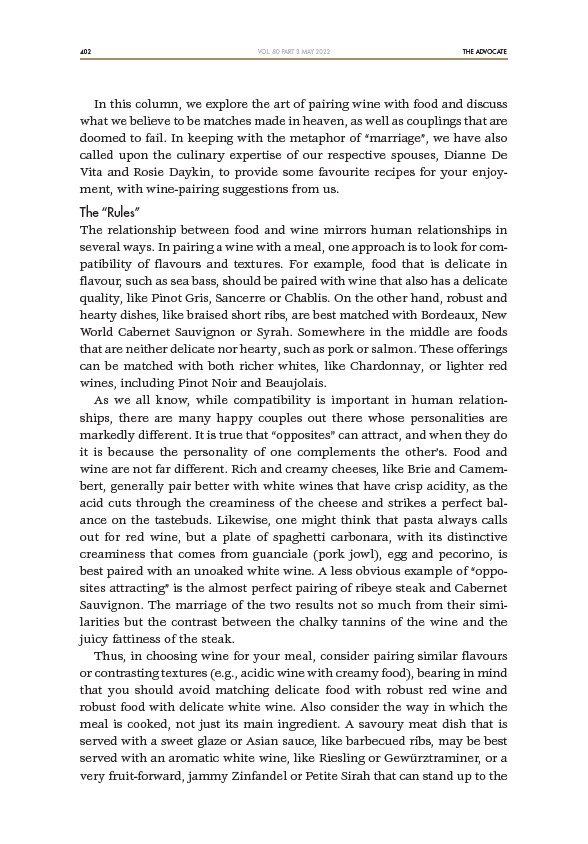
402 THE ADVOCATE
VOL. 80 PART 3 MAY 2022
In this column, we explore the art of pairing wine with food and discuss
what we believe to be matches made in heaven, as well as couplings that are
doomed to fail. In keeping with the metaphor of “marriage”, we have also
called upon the culinary expertise of our respective spouses, Dianne De
Vita and Rosie Daykin, to provide some favourite recipes for your enjoyment,
with wine-pairing suggestions from us.
The “Rules”
The relationship between food and wine mirrors human relationships in
several ways. In pairing a wine with a meal, one approach is to look for compatibility
of flavours and textures. For example, food that is delicate in
flavour, such as sea bass, should be paired with wine that also has a delicate
quality, like Pinot Gris, Sancerre or Chablis. On the other hand, robust and
hearty dishes, like braised short ribs, are best matched with Bordeaux, New
World Cabernet Sauvignon or Syrah. Somewhere in the middle are foods
that are neither delicate nor hearty, such as pork or salmon. These offerings
can be matched with both richer whites, like Chardonnay, or lighter red
wines, including Pinot Noir and Beaujolais.
As we all know, while compatibility is important in human relationships,
there are many happy couples out there whose personalities are
markedly different. It is true that “opposites” can attract, and when they do
it is because the personality of one complements the other’s. Food and
wine are not far different. Rich and creamy cheeses, like Brie and Camembert,
generally pair better with white wines that have crisp acidity, as the
acid cuts through the creaminess of the cheese and strikes a perfect balance
on the tastebuds. Likewise, one might think that pasta always calls
out for red wine, but a plate of spaghetti carbonara, with its distinctive
creaminess that comes from guanciale (pork jowl), egg and pecorino, is
best paired with an unoaked white wine. A less obvious example of “opposites
attracting” is the almost perfect pairing of ribeye steak and Cabernet
Sauvignon. The marriage of the two results not so much from their similarities
but the contrast between the chalky tannins of the wine and the
juicy fattiness of the steak.
Thus, in choosing wine for your meal, consider pairing similar flavours
or contrasting textures (e.g., acidic wine with creamy food), bearing in mind
that you should avoid matching delicate food with robust red wine and
robust food with delicate white wine. Also consider the way in which the
meal is cooked, not just its main ingredient. A savoury meat dish that is
served with a sweet glaze or Asian sauce, like barbecued ribs, may be best
served with an aromatic white wine, like Riesling or Gewürztraminer, or a
very fruit-forward, jammy Zinfandel or Petite Sirah that can stand up to the